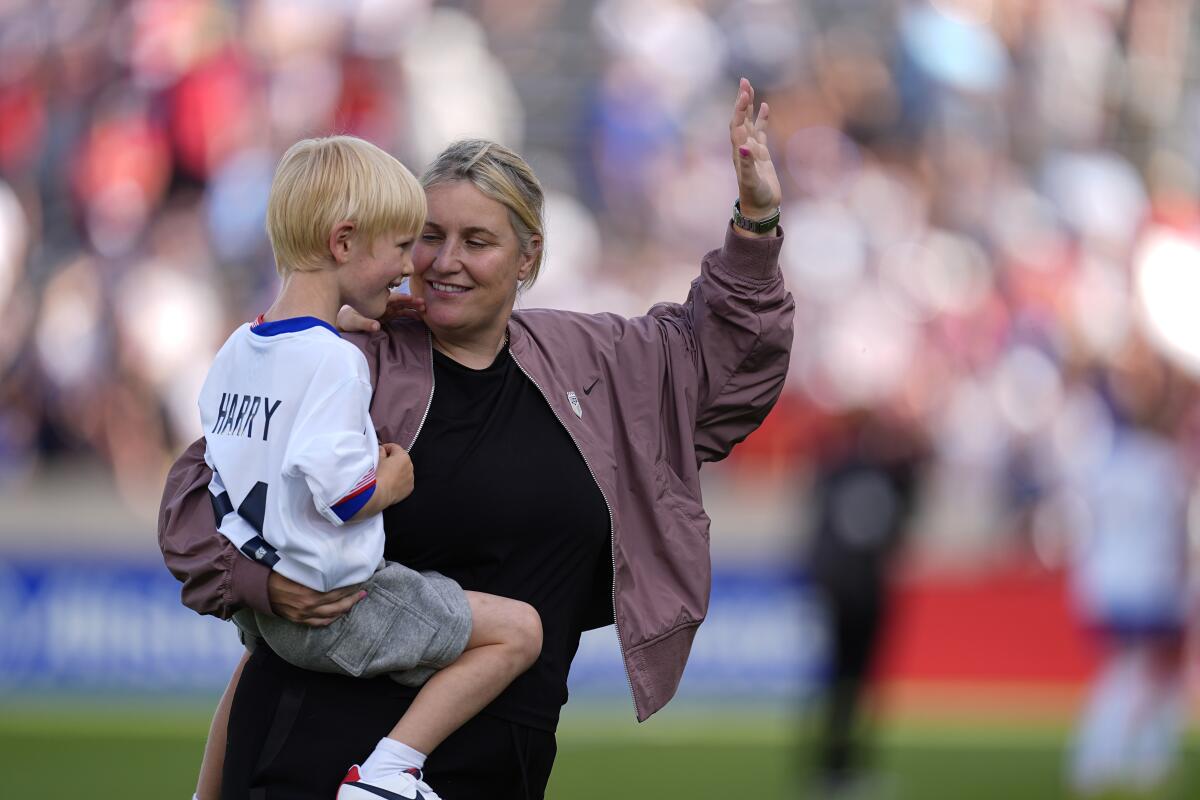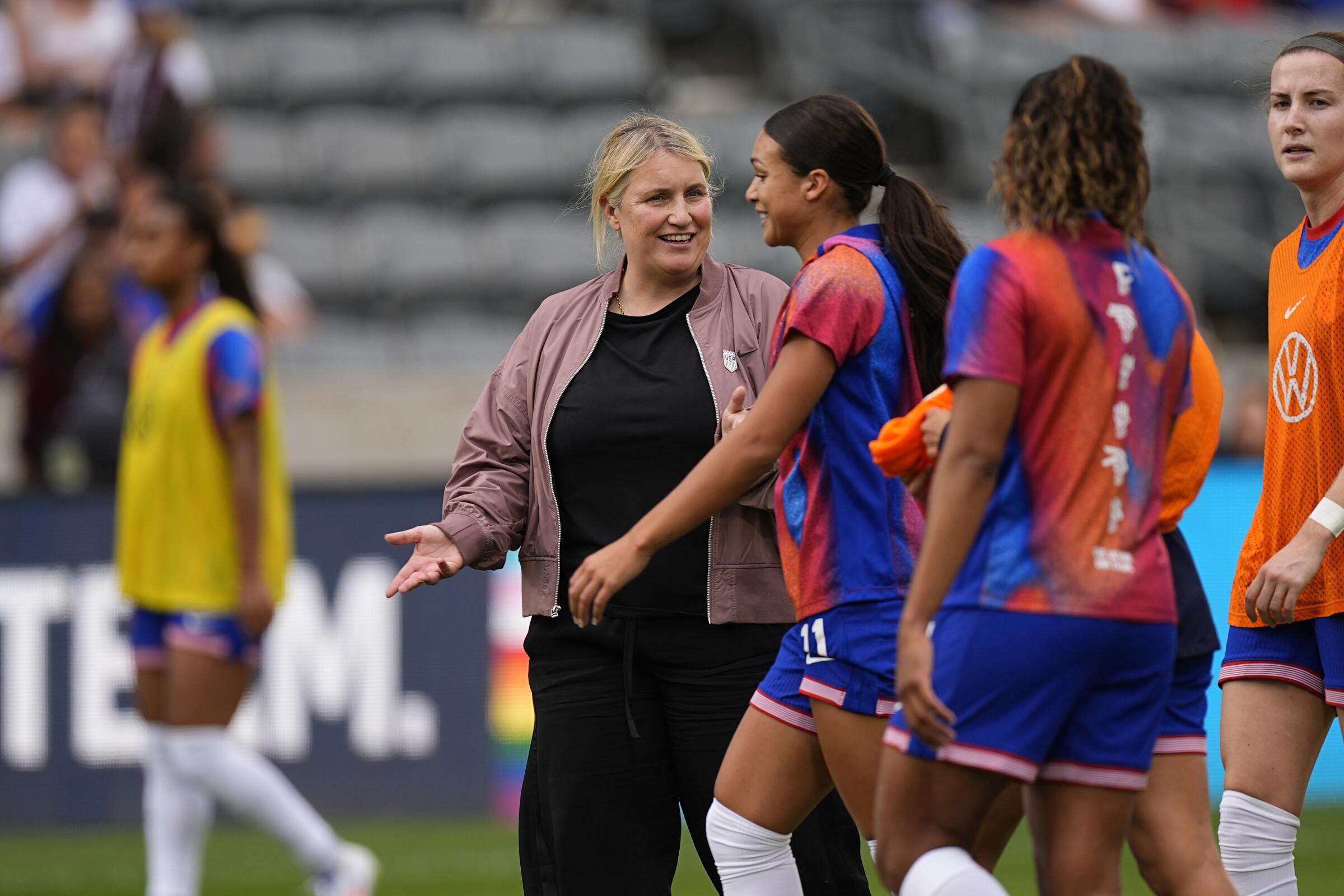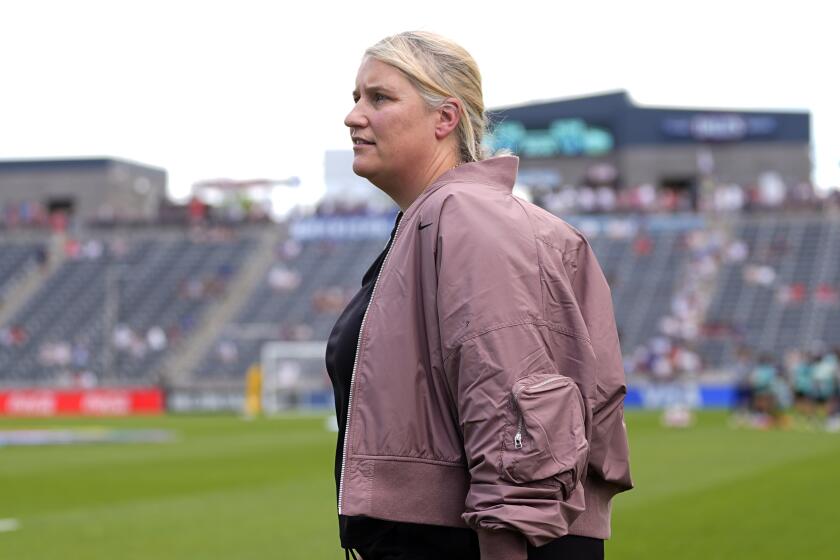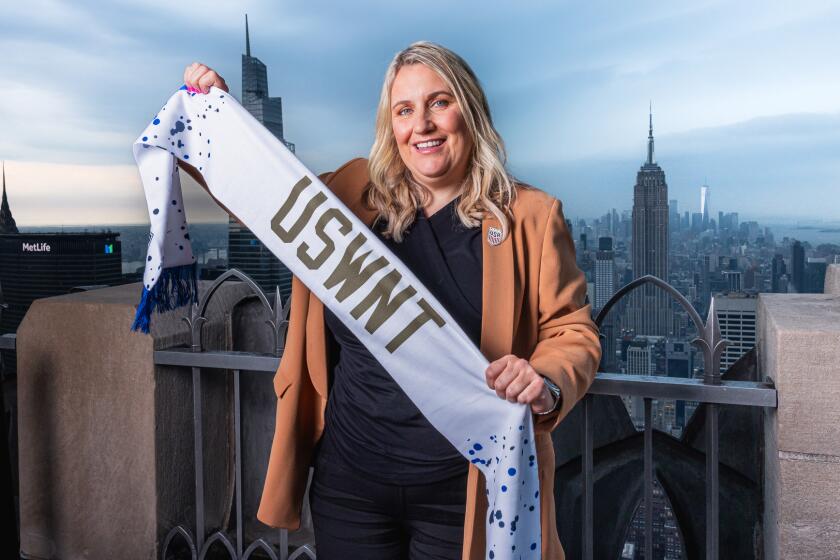Kevin Baxter writes about soccer and hockey for the Los Angeles Times. He has covered seven World Cups, five Olympic Games, six World Series and a Super Bowl and has contributed to three Pulitzer Prize-winning series at The Times and Miami Herald. An essay he wrote in fifth grade was voted best in the class. He has a cool dog.
1
For Emma Hayes, the chance to coach the U.S. women’s soccer team is a dream come true.
It’s the biggest job in the sport, one her father, Sid, pushed her to pursue for more than a decade — and one she finally landed two months after his death.
“I’m doing the job I love,” she said last week. “I get to enjoy these amazing players.”
Yet dreams, as Hayes also knows, can sometimes turn into nightmares. So she’s under no illusion that reviving a national team that has fallen to its lowest point in decades will be easy.
“There’s lots of work to do,” she said after Saturday’s 4-0 win over South Korea in her first game with her new team. “There’s lots of holes in our play.”
The U.S. women’s national team defeats South Korea 4-0 in its first game under coach Emma Hayes as the team looks to build cohesion before the Paris Olympics.
With precious little time to repair them. Hayes has less than four weeks to settle on an 18-player roster for next month’s Paris Olympics, where the U.S. will face what looks to be the deepest field in women’s soccer history, one that includes seven of the world’s top 10 teams, including Canada, the defending Olympic champion, and Spain, the reigning world champion.
After winning its fourth World Cup in 2019, the U.S. stumbled to a bronze medal in the Tokyo Olympics, then exited last summer’s World Cup in the round of 16, its earliest departure from a major international tournament.
Yet it wasn’t just the results that raised eyebrows. In the last Olympics, the U.S. was tactically inept. At the World Cup, the Americans looked overmatched and underwhelmed, failing to score in their last 238 minutes and failing to reach the semifinals for the first time. As a result, the U.S., No. 1 in the world the last eight years, dropped to fourth in the latest FIFA rankings.
“The realities are the world game is where it is and the rest of the world do not fear the USA in the way that they once did,” the London-born Hayes said. “And that’s valid. There are different world champions, there are different Olympic champions. So it’s our job to grasp quite quickly what we need to do to get close again to those levels.”
Since Hayes is a coach and not a miracle worker, that will necessarily take time.
“It’s a process,” she said. “We’ve got to go one step at a time.”

U.S. women’s national soccer team coach Emma Hayes holds her 5-year-old son, Harry, after a 4-0 win over South Korea on Saturday.
(David Zalubowski / Associated Press)
The start of that journey was delayed by Chelsea, the club team Hayes has coached since 2012. It refused to let her out of the last six months of her contract, which kept Hayes in England through the middle of May. So while she tried, through interim coach Twila Kilgore, to manage the team from afar during that time, only now is she getting the chance to implement her strategy and vision in person.
Doing that, she said, starts with building a foundation of trust, which is why she met individually with each of the 27 players she called into her first training camp as coach.
Next comes the long and complex task of introducing her playing style, one that, at Chelsea, was robust in the attack yet emphasized tactical flexibility.
“A lot of what we’ve done in the past six or seven months with her at Chelsea, you don’t get the on-the-field aspect,” captain Lindsey Horan said. “That’s the one big difference that you feel and you see. You finally get your coach out there on the field and the feeling you get, the leadership you get, that’s exciting.”
How long that honeymoon period will last is unknown, of course. The national team has historically included some of the biggest personalities in women’s soccer and that has made it a minefield for coaches. A locker room revolt led to Tom Sermanni’s ouster in 2014 and three years later another group of veterans reportedly went to U.S. Soccer president Sunil Gulati to try to get Jill Ellis fired.
A conversation with her dying father helped persuade Emma Hayes to leave Chelsea and pursue the challenge of revitalizing the U.S. women’s national team.
Gulati backed Ellis, who led the U.S. to a second straight world championship in 2019, but that was the last time the Americans climbed to the top of the medal podium at a major tournament. That decline did little to change the power structure around the team, however, so when players complained about difficult training sessions under Ellis’ successor, Vlatko Andonovski made the practices shorter.
The 16 trophies Hayes won at Chelsea plus her annual salary — reportedly $1.6 million, a record for a women’s coach — probably will make her immune to any attempted coups. Plus the team she has been handed is one in transition.
In Paris, the U.S. will play in a major tournament without Megan Rapinoe, Carli Lloyd or Becky Sauerbrunn for the first time in two decades. If Alex Morgan, who has been battling an ankle injury, doesn’t make the team, the U.S. would have no players with more than 150 international caps and no former Olympic gold medalists on its roster for the first time since the 1996 Olympics.
In their place will be a squad led by Horan, a week past her 30th birthday, and twentysomethings Mallory Swanson, Naomi Girma, Catarina Macario and Sophia Smith. In fact, the lineup Hayes started in her debut averaged 25.5 years of age and 45 caps per player, making it the youngest starting 11 in more than two years.
“We’ve got a good combination in the group. There’s more experienced, less experienced players,” Hayes said. “This is, for us, a new beginning.”
But is it the kind of beginning she dreamed about? Or the beginning of something else?
⚽ You have read the latest installment of On Soccer with Kevin Baxter. The weekly column takes you behind the scenes and shines a spotlight on unique stories. Listen to Baxter on this week’s episode of the “Corner of the Galaxy” podcast.







